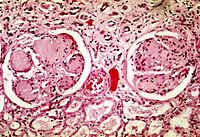
Photo from wikipedia
Acute kidney injury (AKI) with proteinuria is a hallmark of infections with Eurasian orthohantaviruses. Different kidney cells are identified as target cells of hantaviruses. Mesangial cells may play a central… Click to show full abstract
Acute kidney injury (AKI) with proteinuria is a hallmark of infections with Eurasian orthohantaviruses. Different kidney cells are identified as target cells of hantaviruses. Mesangial cells may play a central role in the pathogenesis of AKI by regulation of inflammatory mediators and signaling cascades. Therefore, we examined the characteristics of hantavirus infection on human renal mesangial cells (HRMCs). Receptor expression and infection with pathogenic Puumala virus (PUUV) and low-pathogenic Tula virus (TULV) were explored. To analyze changes in protein expression in infected mesangial cells, we performed a proteome profiler assay analyzing 38 markers of kidney damage. We compared the proteome profile of in vitro-infected HRMCs with the profile detected in urine samples of 11 patients with acute hantavirus infection. We observed effective productive infection of HRMCs with pathogenic PUUV, but only poor abortive infection for low-pathogenic TULV. PUUV infection resulted in the deregulation of proteases, adhesion proteins, and cytokines associated with renal damage. The urinary proteome profile of hantavirus patients demonstrated also massive changes, which in part correspond to the alterations observed in the in vitro infection of HRMCs. The direct infection of mesangial cells may induce a local environment of signal mediators that contributes to AKI in hantavirus infection.
Journal Title: Viruses
Year Published: 2022
Link to full text (if available)
Share on Social Media: Sign Up to like & get
recommendations!